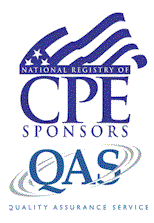Celebrating 26 years serving our friends and customers!
New--H.R. 1 Act - The One Big Beautiful Bill Mini Course
FASB SSARS and SAS Update and ReviewCode: 24-SSARS
Add to Cart
Course Details
636 pages
Objective: To review recent accounting, auditing and compilation and review changes.
The purpose of
this course is to inform the reader of the various changes affecting accounting,
compilation and review, and auditing engagements including newly issued FASB and
FASB statements, new statements issued by the Auditing Standards Board, changes
in compilation and review, and more.
Major Topics:
- Identify types of subsequent events that require disclosure
- Recognize some types of concentrations that might require disclosure under the risk and uncertainty rules
- Identify the definition of near term
- Recall the frequency in which an entity should test goodwill for impairment
- Recognize the formula for testing goodwill impairment
- Recall how to classify business interruption insurance proceeds on the financial statements
- Identify a method that can be used to measure variable consideration revenue
- Recognize an example of a construction-type contract
- Identify a tax-law change made by the CARES Act, and
- Recognize how a company should present CARES Act loan forgiveness on its financial statements.
- Identify a characteristic of a multi-employer plan
- Recall the color coding of funded status of a multi-employer plan
- Recognize an argument for not amortizing goodwill
- Identify an example of a customer-related asset
- Recognize a key change made to GAAP by the new lease standard
- Identify a type of lease that exists for a lessee under ASU 2016-02
- Recall a type of lease for which the ASU 2016-02 rules do not apply
- Recognize some of the criteria that determine whether a contract is or is not a lease
- Identify how a lessee should account for initial direct costs
- Recall how a lessor should initially account for initial direct costs for a lease in certain instances
- Identify how a lessor should account for lease payments received on the income statement for an operating lease
- Recognize how certain existing leases are accounted for on the implementation date of ASU 2016-02
- Recall the potential impact that the new lease standard might have on a lessee's EBITDA
- and debt-equity ratios.
- Identify the category of securities for which ASU 2016-01 retains the three categories under existing GAAP
- Recall one of the changes made by ASU 2016-01 to existing GAAP for financial instruments.
- Recall how available-for-sale debt securities are measured on an entity's balance sheet
- Identify how held to maturity securities are measured on the balance sheet
- Recognize how an entity should account for a temporary impairment
- Recall how an entity should present an unrealized gain or loss on an equity security under ASU 2016-01
- Identify how a mutual fund that invests in debt and equity securities should classify the investment
- Recall a change made to the exemption for fair value disclosures with respect to trade receivables and payables
- Recognize the model that ASU 2016-13 uses to deal with credit losses
- Identify how credit losses should be recorded under new ASU 2016-13
- Identify some of the disclosures required by ASU 2016-13
- Recognize a precondition for an accountant to accept a SSARS engagement
- Recall whether the preparation of financial statements standard is an attest or nonattest service
- Identify whether a report is required in a preparation of financial statements engagement
- Recognize what the reporting requirements are, if any, when a "no assurance" legend is
- omitted from prepared financial statements under the AR-C 70 standards
- Identify where to disclose GAAP departures in a preparation of financial statements engagement
- Identify factors that should consider in determining materiality in a review engagement
- Recognize a change that SSARS No. 25 makes to the accountant's review report
- Identify the term that GAAP uses for management's assessment of an entity's going concern
- Recall some of the items that should be documented in a review engagement
- Identify the types of audit reports that can be issued under new AU-C 700A
- Recognize an acceptable title for an auditor's report
- Recognize the order in which certain sections of the new auditor's report should be presented in AU-C 700A
- Recognize the requirements and limitations with respect to communicating on key audit matters in accordance with new AU-C 701
- Recognize examples of modified opinions as defined in AU-C 705A
- Identify examples of situations in which an auditor must or may include an emphasis-ofmatter or other-matter paragraph as required by new AU-C 706A
- Recall examples of fraud risk factors expanded by SAS No. 135
- Identify expanded procedures auditors of ERISA-plan financial statements must perform in newly issued SAS No. 136, including a review of the draft Form 5500
- Identify the new ERISA Section 103(a)(3)(C) audit in SAS No. 136
- Recognize the scope of the terms -other information- and -annual report- as used in the newly issued SAS No. 137 pertaining to auditing and reporting other information, and
- Recall how an auditor should label other information in the auditor's report.
- Recognize the new definition of materiality found in SAS No. 138
- Identify certain paragraphs in the new auditor's report on a special purpose framework.
Presentation Method: Self-Study
Category: Accounting-16, Auditing-8
CPE credit: 24 Hours
Program Level: Update
Prerequisites: None
Advance Preparation: None
Exam expiration date: Participants must submit exams for grading within one year from the date of purchase



